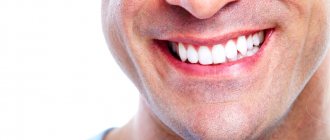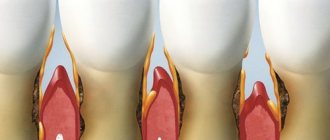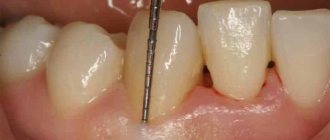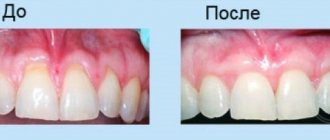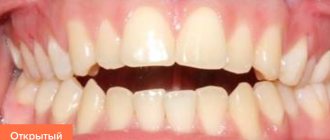Gingivitis is easily suspected by the changed appearance of the gums and the appearance of bad breath. The disease develops with inflammation of the gum edges above the teeth and interdental papillae. An increase in the size of gum tissue is periodically diagnosed. Left unattended, gingivitis can develop into periodontitis, and then there is a risk of tooth loss due to changes in the bone.
Dentists distinguish three forms of gingivitis:
- Catarrhal;
- Ulcerative-necrotic;
- Hypertrophic.
Classification of gingivitis according to ICD:
- K05.0. Acute gingivitis
- K05.00 Acute streptococcal gingivostomatitis
- K05.08 Other specified acute gingivitis
- K05.09 Acute unspecified gingivitis
- K05.1. Chronic gingivitis
- K05.10 Simple marginal gingivitis
- K05.19 Chronic unspecified gingivitis
- K06.0. Gum recession.
- K06.1. Gingival hypertrophy.
- K06.2. Lesions of the gums and edentulous alveolar margin caused by trauma.
- K06.9. Changes in the gingiva and edentulous alveolar margin, unspecified.
Periodontal diseases. General idea.
Periodontium is a complex of tissues surrounding the tooth (gingiva, circular ligament of the tooth, alveolar bone and periodontium), closely related anatomically and functionally.
WHO proposes that “periodontal diseases include all pathological processes that occur in it. They can be limited to any one component of the periodontium (gingivitis), or affect several or all of its structures” (WHO, series of technical reports No. 207. Periodontal diseases. Geneva, 1984). These recommendations are consistent with those that are common in our country and abroad.
Classification
In November 1983, at the meeting of the XVI Plenum of the Board of the All-Union Society of Dentists, a classification of periodontal diseases was adopted, which also corresponds to the tasks of pediatric dentistry, which is more widely used than the international one (ICD-10).
- Gingivitis is an inflammation of the gums caused by the adverse effects of general and local factors and occurring without compromising the integrity of the dentogingival attachment. Forms: catarrhal, hypertrophic, ulcerative.
- Course: acute, chronic, aggravated, remission.
- Prevalence: localized, generalized.
- Severity: mild, moderate, severe.
- Course: acute, chronic, aggravated (including abscess), remission.
- Course: chronic, remission. Severity: mild, moderate, severe. Prevalence: generalized.
International Classification of Periodontal Diseases (ICD-10, 2004)
- K 05. Gingivitis and periodontal diseases.
- K 05. Acute gingivitis.
Excluded:
gingivostomatitis caused by the herpes simplex virus (BOO.2), acute necrotizing ulcerative gingivitis (A 69.1).
- By 05.1. Chronic gingivitis.
- By 05.2. Acute periodontitis.
Excluded:
acute apical periodontitis (K 04.4), periapical abscess (K 04.7) with a cavity (K 04.6).
- By 05.3. Chronic periodontitis.
- By 05.4. Periodontal disease.
- By 05.5. Other periodontal diseases.
- By 05.6. Periodontal disease, unspecified.
- K 06. Other changes in the gingiva and edentulous alveolar margin.
Excluded:
atrophy of the edentulous alveolar margin (K 08.2).
- Gingivitis: NOS (K 05.1);
- acute (K 05.0);
- chronic (K 05.1).
- By 06.0. Gum recession.
The clinical forms of periodontal disease in children have many differences from similar conditions in adults.
This is explained primarily by the fact that all pathological processes, caused by various reasons, develop in a child in growing, developing and restructuring tissues that are morphologically and functionally immature, and because of this they can react inadequately and differently to similar stimuli and causative factors that cause the disease periodontal disease in adults.
In addition, of great importance in the pathogenesis of the development of the disease is the possibility of disproportion in the growth and maturation of immature structures, which can arise both within the system (tooth, periodontium, alveolar bone, etc.), and in the structures and systems that provide and adapt the entire body to external conditions from birth to old age.
All this causes juvenile chronic gingivitis, periodontitis and periodontal disease, which arise as a result of temporary transient functional juvenile hypertension, juvenile carbohydrate metabolism disorders (juvenile diabetes, diencephalic syndrome, etc.).
Previously, it was believed that periodontal disease does not occur in childhood or adolescence. According to Kantorovich (1925), periodontal disease (periodontitis) is not observed before the age of 18, even under particularly unfavorable general and local conditions, and before the age of 30 it is very rare. Currently, a number of observations confirm that all forms of periodontal disease can occur in childhood.
In the dental department of the Faculty of Pediatrics in Prague, cases of periodontal damage were observed in the presence of temporary teeth with not yet formed roots. There are two forms of periodontal disease, which differ from each other clinically. Both forms begin with gingivitis. In some cases, the process develops very slowly: extensive damage to periodontal tissue occurs only at an older age, in others, periodontal destruction has been observed for several months. The authors explain this by the primary inferiority of the periodontium.
Three groups of children were studied: 1) preschoolers; 2) schoolchildren; 3) children suffering from diathesis. In group 1, 44 children were studied 3 times - at 4, 5 and 6 years of age. In 24.3% of them, gingivitis was diagnosed 1 time, in 3.5% - 2 times. The disease was diagnosed in 1.26% of children in all 3 groups. In the 2nd group (500 children) there were schoolchildren aged 10-12 years. They were examined once. The incidence of gingivitis increased with age. A more rapid course is observed in 10-14 year old children with diabetes. If in young children there is a direct dependence of gingivitis on anomalies and oral hygiene, then in the period preceding puberty, the number of anomalies decreases, and the number of gingivitis increases. In 10-year-old diabetic patients, gingivitis was detected in 37.1% of cases, in 14-year-old patients - in 73.8%. In childhood, quite often early gingivitis ends with the formation of pockets, bone resorption and loosening of teeth. In addition to inflammatory processes, uniform atrophy of the dental alveoli and gums occurs, as well as periodontitis associated with periodontal degeneration and tooth displacement.
Periodontal disease that occurs in childhood differs in certain respects from that in adults. This difference is explained by the peculiarity of metabolism in children, differences in the anatomical structure of the developing and already formed periodontium.
Recognition of periodontal disease in temporary dentition is complicated by the fact that loosening of teeth, which is the most obvious symptom, is difficult to differentiate from the process of resorption during physiological change of teeth. Due to the fact that in temporary teeth the course of periodontal disease in most cases is slow and protracted, since temporary teeth even under intact conditions fall out within 6-10 years, the clinic usually pays attention only to pronounced, severe forms. Milder cases are considered to be early loss of primary teeth.
The importance of recognizing periodontal disease in childhood is explained by the fact that in most cases it accompanies some general disease of the body. As a symptom of anemia, hypovitaminosis, malnutrition, metabolic or endocrine disease, and sometimes a disease of the hematopoietic system, well-recognized and characteristic changes also appear on the periodontium. Correctly diagnosed periodontal disease draws the doctor's attention to a possibly hidden general disease. In the case of periodontal disease in primary teeth, the same changes can be expected during the development of permanent teeth. Therefore, pediatric dentists sometimes have to engage in timely recognition and thorough treatment of periodontal diseases.
Causes of periodontal disease
Children react to harmful influences faster and more sharply than adults. The cure of the disease as a result of the significant regenerative ability of the young organism occurs faster and more completely. The occurrence of periodontal diseases in childhood can be reduced to both local causes and general diseases of the body.
The concept of “childhood” includes the age from the beginning of the eruption of a temporary tooth to the end of the change of teeth. Acute marginal periodontitis is observed in children more often than in adults. In the area of temporary molars, the process usually extends to the level of root bifurcation. The interroot septum melts. Children are characterized by phlegmonous infiltration of the gingival papilla.
There are three forms of periodontopathy:
- accidental, caused by local irritating factors;
- symptomatic, in which periodontopathy accompanies lesions of other organs;
- idiopathic, the cause of which has not been established.
The reason for the first form in a temporary bite is the same as in a permanent one: dental plaque, carious defects in the area of the tooth neck, irritating prosthetic structures. Symptomatic periodontopathy occurs with keratoma of the hands and feet due to neurosis. However, the connection between ectodermal dysplasia and periodontopathy cannot be considered firmly established. In children (as in adults), this form is associated with hormonal disorders, blood diseases, mongolism and tetralogy of Fallot. It is believed that with the introduction of immunohematological reactions, the diagnosis of periodontal diseases will improve and the symptomatic group will further decrease.
While changes in the body create a predisposition to disease, local causes are the factors that cause disease. Bone formation and destruction occur constantly in the body throughout life. In healthy adults, these two processes are in a state of equilibrium. In the developing young organism, bone formation predominates. Its death occurs only if, for some reason, bone destruction begins to predominate. As a result of the significant resistance and regenerative capacity of the body in childhood and during puberty, the effect of local factors causing the disease is usually less pronounced than in adults. Various general changes in the body are of great importance.
Thus, the development of periodontitis is more often observed in cases of metabolic disorders, circulatory disorders, endocrine system disorders, nutritional diseases or severe vitamin deficiencies.
Local factors
Of the local factors causing the disease, gingivitis , as well as occlusal-articulatory anomalies, play a certain role. Although gingivitis at a young age is quite common, the inflammatory process relatively rarely leads to the death of periodontal tissue; bone resorption develops only in the case of widespread, severe ulcerative stomatitis or recurrent chronic gingivitis.
Gingivitis causes the formation of tartar. In children, tartar deposits are observed relatively rarely, with very poor oral hygiene or in connection with certain diseases (diabetes, congenital heart disease). Often there is a change in the color of the crown of the teeth and the formation of plaques. The discoloration occurs in the cervical part of the tooth crown from the vestibule of the oral cavity and manifests itself in the form of delimited dark brown, greenish or pink spots; they can only be removed by strong friction.
Causes of gingivitis
1) Local factors4
- Poor oral hygiene. This is the most popular reason, since bacteria multiply in plaque and tartar, which are formed due to insufficient hygiene, which provoke gum inflammation.
- Injuries and burns to the mucous membrane due to eating hard or hot foods. If they are regular, the wounds can become infected, which also contributes to inflammation.
- Injury to gums from old fillings, crowns, and braces.
- Smoking. Tar and other substances from cigarettes settle on the teeth, forming plaque and irritating the gum mucosa; nicotine, in turn, impairs blood flow to the gums.
- Eruption of wisdom teeth. If a tooth is cut for a long time and incorrectly, it can become a source of constant inflammation and provoke gingivitis.
2) General factors
- Poor diet with insufficient vitamins
- Weakened immunity, immunodeficiency states
- Long-term, incorrect use of antibiotics
- Allergy
- Impaired metabolism
- Digestive system diseases (Crohn's disease)
- Frequent sore throats, tonsillitis, sinusitis
- Stress
- Pregnancy, as it changes hormonal levels and the worst effect is on the gums
- Diabetes
Diagnosis of the disease
Diagnosis of catarrhal gingivitis involves examination by a doctor and laboratory tests.
The latter allow you to determine indicators such as:
- bleeding gums;
- degree of inflammation;
- amount of microbial plaque.
When conducting an examination, the dentist pays special attention to the following factors:
- how full the blood vessels of the gums are;
- red gums;
- integrity of the periodontal junction;
- the presence and amount of plaque and tartar;
- presence of signs of destruction of the interalveolar septa.
Symptoms of gingivitis
- Bleeding gums are the main symptom of gingivitis. Bleeding can occur both while brushing your teeth and when eating. Spontaneous bleeding also occurs
- Swelling and swelling of the gums, which can make teeth appear smaller.
- Pain of varying severity
- Change in gum color: it becomes bright red or blue.
- Deterioration of general condition, fever, weakness, headache
The presence of symptoms and their severity depends on the form and severity of the disease.
Classification
Practicing dentists use a clinical classification of the disease, which involves dividing it according to the form of its course, the nature of the lesion and the localization of the inflammatory process. Depending on the course, gingivitis is divided into two types:
- Acute - occurs suddenly and occurs with pronounced symptoms that cause significant discomfort to the patient.
- Chronic – characterized by a long course with periods of exacerbation and remission. As a rule, the inflammatory process with this form of gingivitis worsens in winter or spring, which is due to a lack of vitamins and minerals in the body.
Based on the degree of spread, localized and generalized gingivitis are distinguished. In the first case, the disease affects one or more unrelated areas of the gum. In the second case, the inflammation covers a large area of the gingival margin, affecting one or both jaws (upper and lower).
Classification according to the nature of the lesion takes into account the difference in the clinical picture of the disease and provides for four types of gingivitis:
- Catarrhal is a common form of pathology, manifested by pain in the affected area, swelling and bleeding, which can occur while eating or brushing teeth.
- Ulcerative-necrotic - gingivitis of this type is characterized by the development of necrosis (death) of tissue with the formation of ulcers and general intoxication of the body.
- Atrophic – occurs against the background of a decrease in the volume of the gums and exposure of the dental neck. If left untreated, progressive gingivitis causes the patient's tooth roots to become exposed.
- Hypertrophic – manifested by an increase in gum papillae and is most often a consequence of vitamin C deficiency or hormonal imbalance.
The severity of a particular form of the disease is determined by the nature of its course and its spread throughout the periodontium. In particular, the mild degree is characterized by moderate symptoms of gingivitis and damage mainly to the interdental papillae. In moderate pathology, the inflammatory process covers the papillae and marginal gum, and in severe form it affects the entire gum, including its alveolar part.
Forms of gingivitis
Catarrhal gingivitis
The most common form of gingivitis is the classic form. Many people encounter it at school, but do not pay attention. If you experience even slight bleeding while brushing your teeth, you should immediately consult a doctor. In addition to bleeding, symptoms such as bad breath, itching, and burning may occur.
Hypertrophic gingivitis
With this form of the disease, the gum increases in size and can cover half of the tooth or more. This form of gingivitis can be caused by hormonal changes in pregnant women and adolescents, as well as by taking medications.
Ulcerative gingivitis
The most dangerous and difficult to tolerate form of gingivitis, it causes necrosis (death) of the gums, severe pain, and a very sharp and unpleasant odor from the mouth. Sometimes it is painful for a person suffering from ulcerative gingivitis to even eat and speak, and the general condition is also disturbed. This form of gingivitis affects people with weakened immune systems.
Desquamative gingivitis
It manifests itself as swelling, bleeding and pain in the gums. The gums become bright red, “glazed”, and are easily injured.5
Atrophic gingivitis
It is characterized by a decrease in the size of the gums: it becomes thin, easily injured, and the roots of the teeth are exposed. The teeth seem longer, pain appears from cold or hot things. This form of the disease is rare.
Treatment with folk remedies
All “grandmother’s” advice for gingivitis is of an auxiliary nature. You cannot refuse traditional treatment, relying on “time-tested recipes.” This is not stated anywhere, but in ancient times, people, using exclusively natural raw materials, lost their teeth extremely early - by modern standards. It is worth taking advantage of the achievements of science to preserve a beautiful and healthy smile for many years.
As maintenance therapy, it is allowed to use rinses with tinctures and decoctions of herbs (excluding alcohol). Chamomile, St. John's wort, and eucalyptus are beneficial. A side effect of this treatment will be rapid darkening of tooth enamel. Therefore, special herbal remedies produced on an industrial scale will be a worthy alternative to home preparations.
The roots of the teeth are exposed - what to do and how to treat them
Splinting teeth for periodontitis with fiberglass and tape
Treatment of generalized moderate and severe periodontitis
Open and closed curettage of periodontal pockets
Laser gingivotomy - surgical treatment of complex forms of periodontitis
Catarrhal and hypertrophic gingivitis symptoms and treatment in adults
Diagnosis of gingivitis
It is always important to collect a complete history of the disease, because gingivitis is often a chronic disease that occurs in childhood.6
It is also worth paying attention to the general condition of the body; the dentist may refer you to other specialists.
Consultation with an endocrinologist – in diseases of the endocrine system (diabetes mellitus, hyperfunction of the thyroid gland and adrenal glands), gum inflammation is more active.
Consultation with a hematologist – in case of blood diseases, gum inflammation is only a symptom of the underlying disease. Consultation with a hematologist is required for differential diagnosis and comprehensive treatment.
Consultation with a gastroenterologist – gingivitis is usually accompanied by chronic diseases of the digestive system.
Related doctors, in turn, prescribe a number of other tests to treat pathology, for example, a general blood test, biochemical blood test, gastroscopy, ultrasound, etc.
The dental office conducts diagnostic tests such as:
- Probing is a diagnostic method in which the characteristics of the attachment of the gums to the teeth are determined.
- Staining the gums with iodine-containing solutions: this shows whether the gums are inflamed. With gingivitis, the gums turn shades of brown.
- Determining the level of hygiene, that is, how well a person brushes his teeth.
- Panoramic X-ray of the teeth: This is necessary to see whether the inflammation has affected the bone or not, and also shows the condition of all teeth, fillings and crowns.
Diagnostic methods
A visual examination by a dentist may be sufficient to assess the disease. If symptoms are severe, the doctor may refer the patient for an x-ray. This is necessary if infection of the pulp, periodontal and bone tissue is suspected.
In the presence of ulcers or chronic inflammation, a microbiological analysis is performed, which identifies the type of bacteria and their resistance to antibiotics. If a generalized form is diagnosed, then additional diagnostics are carried out by relevant specialists: ENT doctor, gastroenterologist, immunologist, and other specialists. The patient donates blood for general tests, sugar, HIV infection, syphilis.
Answers to popular questions
How to stop bleeding gums at home?
Herbal rinses (for example, oak bark) will help stop the bleeding, but they only give a temporary effect and mask the problem.
Can a hard brush cause gingivitis?
No, the brush itself does not cause gingivitis, but too hard bristles can damage the enamel. For most people, medium-hard brushes are suitable.
I don’t have problems with my gums, but my gums often hurt and bleed in only one place, what should I do?
It's worth seeing a doctor. Most likely, there is an old filling in this place, in which food gets stuck and inflammation begins.
Is gingivitis curable or is it permanent?
Fortunately, yes, if you follow all the recommendations, you will not only cure gingivitis, but also not see it again.
Treatment of gingivitis
Treatment of gingivitis is always complex.
- Local treatment
- General treatment
Local treatment of gingivitis
1. Removing plaque and stone. Since stone and plaque are the main causes of gingivitis, they must be removed to get rid of the disease. This is done using special dental instruments, ultrasound, laser, hand instruments - the method is selected depending on the condition of the gums. If gingivitis has already occurred, simply brushing your teeth well at home will not be enough; you need to consult a doctor.
2. Treatment of caries and its complications , replacement of old crowns and fillings.
If there are injuries from braces, it is necessary to use special wax. 3. Drug therapy includes antiseptics, anti-inflammatory, antibacterial and painkillers, depending on the form of gingivitis.
4. Surgical operations. If the gums have grown excessively, or, conversely, have exposed the roots of the teeth too much, surgical intervention may be required.
5. Training in proper hygiene. This is necessary to consolidate the results of treatment and speedy recovery. The doctor helps you choose the right medications
hygiene and teaches proper teeth brushing.
Treatment methods
With early diagnosis of the disease, gum health can be completely restored in 7 to 10 days. If gingivitis is not cured in a timely manner, long-term therapy will be required. Treatment methods depend on the type, severity of the pathology, causes of development, and age of the patient.
The complex of treatment measures includes:
- professional hygiene in dental clinics to clean teeth from deposits and stones;
- sanitation of the oral cavity to remove pathogenic microorganisms and their metabolic products;
- taking vitamins, antihistamines, antioxidants and other medications prescribed by a doctor;
- rinsing the mouth with solutions for antiseptics, relieving inflammation, accelerating tissue healing;
- surgical operations for hypertrophic, atrophic forms (excision or augmentation of gums);
- correction of hygiene procedures - replacing a hard brush with a soft one, consulting a dentist on proper oral care and nutrition.
For inflammatory gum disease, traditional medicine methods can and should be used. How to rinse your mouth with gingivitis? Doctors recommend using decoctions of chamomile, sage, calendula, and oak bark. If there are no herbs, you can prepare a soda solution. Rinse should be done after every meal.
Prevention of gingivitis
It's always easier to prevent something than to treat it. Therefore, it is very important to follow the recommendations below:10
- You need to brush your teeth 2 times a day: morning and evening
- After each appointment, it is not necessary to brush your teeth, but you should rinse your mouth with water
- It is very important to use all personal hygiene products and do it correctly, you need dental brushes and dental floss
- Visit your dentist once or twice a year for a checkup and professional cleaning. It will remove plaque and be able to recognize gingivitis at an early stage
- Treat all concomitant diseases of the body.
- If installed structures in the mouth (fillings, dentures, braces) injure the mucous membrane, consult a doctor.
- Lead a healthy lifestyle: exercise, exercise, eat right
These measures will help you avoid gum disease and keep your mouth healthy.
